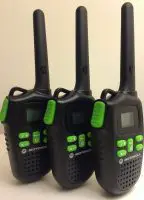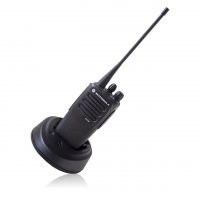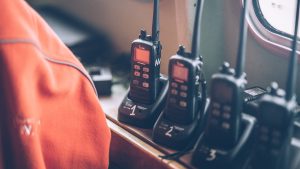If you’re new to the walkie talkie world, you might have encountered the term “two-way radio” at some point. Some people use these terms interchangeably so you might assume that walkie talkies and two-way radios are one of the same.
It is important to understand the distinction between the two to ensure you don’t end up purchasing the wrong type of product. In this guide we will answer whether walkie talkies are the same as two-way radios and discuss some of the key aspects of each one.
Table of Contents
What is a Two-Way Radio?
The term “two-way radio” sounds very high tech, but it simply refers to radio technology that allows people to communicate using radio waves. Someone who possesses a two-way radio can transmit audio and specific data types to others through radio waves. They can also receive audio and data from another person that is using a two-way radio.
This definition makes two-way radios sound like an incredibly broad range of devices, because they are. You can find two-way radios designed to specifically communicate with a set of specific devices. Similarly, there are two-way radios that communicate using encrypted networks capable of transmitting and receiving audio and data across an entire country.
What is a Walkie Talkie?
If you guessed that the two-way radio definition given above sounds like it could also cover talkie walkies, then your guess would be correct. Walkie talkies are a type of two-radio. In fact, they’re one of the most commonly used two-way radio devices out there.
Walkie-talkies have become incredibly popular in recent decades because they are compact and can be carried around just about anywhere. This makes them useful for camping trips, skiing trips, and group fishing trips.
Key Differences Between Walkie Talkies and Other Two-Way Radios
While size and portability is usually the most noticeable factor that distinguishes walkie talkies from other types of two way radios, there are many more characteristics that set them apart. This includes:

Frequency Range
Looking at a 2 way radio frequency chart, it is easy to see that two-way radios operate over a wide range of frequencies. If we put most two-way radios together, the group would cover a frequency range of 130 MHz to 900 MHz. A special subset of two-way radios called ham radios are authorized to use AM radio band frequencies of between 1.6 MHz and 1240 MHz.
By contrast, walkie talkies occupy a very narrow frequency range. The typical walkie talkies band is between 400 and 500 MHz, with some devices using 27 MHz and 900 MHz bands. However, the vast majority of consumer walkie talkies operate within the 462 and 467 MHz range, so these are the frequencies you can expect to use if you pick up a walkie talkie at your local store.
Licenses
The FCC requires users with specific types of two-way radios to possess a license to operate their devices. This includes Business (BRS) and GMRS radios.
You don’t need a license to operate a walkie talkie in most cases. However, some walkie talkies are capable of working in both FRS and GMRS frequency ranges. If you intend to use some of the frequencies assigned for GMRS, you will need to get a license from the FCC. However, few walkie talkie users ever need to use GMRS frequencies, so you likely won’t need to worry about obtaining a license once you purchase a walkie talkie.
Power Level
Walkie talkies are handheld devices that operate on batteries. As a result, these devices have relatively low power levels. Most walkie talkies offer anywhere from 0.5W to 5W of power. This power also correlates to their range, so these devices have relatively limited range of just a few miles.
Other types of two-way radios have much higher power levels. For example, two-way radios with a base offer up to 50W. Some business radios offer a whopping 125W. These two-radios also have long ranges thanks to their higher power levels. This makes them useful for broadcasting communications between towns and cities.
Durability
Walkie talkies stand out in the two-way radio world thanks to their portability. People take such devices into different settings such as out in the snow, on boats, and into the desert. Walkie talkies must be incredibly durable to continue functioning in such environments.
For this reason, the vast majority of walkie talkies have high IP ratings. This means they have good dust resistance and water resistance. A subset of walkie talkies are even waterproof.
By contrast, other types of two-way radios aren’t designed to be used outdoors. Therefore, they lack the dust and water protection capabilities that walkie talkies possess.
Should You Use the Term Walkie Talkie and Two-Way Radio Interchangeably?
Now that you know that walkie talkies are a type of two-way radio, you might be wondering if you can use the two terms interchangeably. The answer depends on the situation.
For example, if you’re planning to purchase a walkie talkie, you might end up stumbling onto the wrong kind of device by browsing through a selection of different two-way radios.
Similarly, if you’re planning communicate with someone on an outdoor trip, you should probably specify that you will be using a walkie talkie instead of a two-way radio, as the other party might get the impression you own a device that operates on frequencies other than the ones that your average walkie talkie uses.
Learning More About Walkie Talkies
As you can see, there are many key differences between walkie talkies and other types of two-way radios. So keep this distinction in mind the next time you set out to buy one of these devices.
If you want to learn more about walkie talkies, such as which walkie talkie channels to use or what the best channel for walkie talkies is, please consider checking out the rest of our guides. We offer useful information for both beginner and advanced walkie talkie users and can teach you how to select and use these devices effectively.





